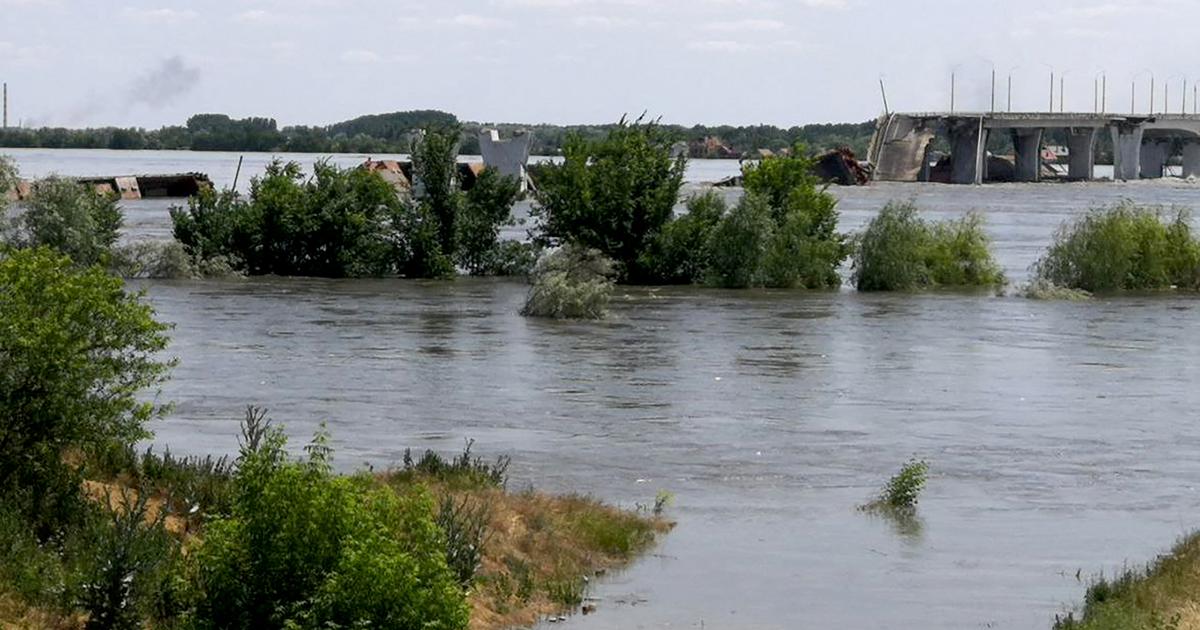Two days after the explosion that partially destroyed the Nova Kakhkova dam, the scale of the coming ecological disaster remains difficult to measure. The two belligerents blame each other for the disaster: Ukraine denounced an "ecocide", Prime Minister Denys Chmyhal on Wednesday accusing Russia of having caused "one of the worst environmental disasters in recent decades". Putin retorted in the late afternoon that this "barbaric act" constituted "a large-scale environmental and humanitarian catastrophe", blaming Ukraine for a crime that, a priori, would benefit Russia more militarily.
To discover
- Follow the news about the war in Ukraine with the application of Le Figaro
The volume of water held by the dam alone gives a good idea of the extent of the damage that its destruction will cause. The Kakhovka reservoir contained nearly 18 billion tons of water, a distance of about 240 kilometers long and 23 kilometers wide. Satellite images released Tuesday night already showed huge flooding downstream. On the ground, hundreds of videos, posted by civilians on social networks, revealed floods of garbage, sediment, pieces of houses, or dead animals carried by rising waters. In Nova Kakhovka, the zoo was completely flooded, according to an animal protection association that reported the death of all animals except swans.
" READ ALSO "War in Ukraine: drowned earth, scorched earth"
According to the Ukrainian government, 150 tons of machine oil have spilled into the river, and another 300 tons could seep in again. "There is a smell of motor oil," Ukrainian MP Oleksiy Goncharenko said Tuesday in a video posted on Twitter.
Chemical pollution
In preliminary conclusions, the Ukrainian NGO Ecoaction fears direct pollution of the river by the dumping of "garbage, agrochemicals and other hazardous materials, as well as flooding and deactivation of wastewater treatment systems". Associate researcher at the Foundation for Strategic Research, Franck Galland abounds. "Like the flood of the Seine in 1910, or that of 2002 in Prague, the chemical and pyrotechnic pollution of the soil will be disastrous for decades." The specialist evokes the discharge of sewers, fuel tanks, garage emptying, "and even, this time, anti-personnel mines that risk traveling, carried by the river". In addition to soil pollution, there is also groundwater pollution. "They interact with the Dnieper, and there can potentially be rises in very remote territories," worries the researcher.
The drainage also risks disturbing ecosystems from Ukraine's largest river to the coastal areas of the Black Sea. Ecoaction fears the potential pollution of several national natural parks, refuges of dozens of protected species, including the Black Sea Biosphere Reserve classified by Unesco. The Dnieper Delta is also home to wetlands protected by the International Ramsar Convention. A terrain of sand and swamp, the steppes of Oleshky Park will also be completely remodeled. "We are witnessing an ecological disaster that also affects the coastal countries of the Black Sea, close to the delta," adds Franck Galland.
Draining of agricultural land
In addition, the drop in the water level upstream leads to "a high risk of water shortage in the most affected regions", warns the Ukrainian NGO. Built during the Soviet era in the 1950s, the water reservoir retained by the Kakhovka dam irrigates the southern part of Ukraine, one of the driest in the country. Several hundred thousand hectares of agricultural land could have to go without irrigation.
In addition to the risk of drying out, the decrease in water level may also "deteriorate water quality due to the decomposition of dead organisms," fears Ecoaction. The destruction of the dam is therefore a major risk to access to water for millions of people.
«
Destroying such a work, which is essential to people's lives, is clearly ecocide," says Franck Galland. Such structures are highly protected by international humanitarian law: "Installations containing dangerous forces, namely dams, and nuclear power plants, shall not be subject to attack," the Geneva Convention states. Added to this is the risk of a humanitarian disaster, which could further weaken the Ukrainian economy, a country among the world's largest grain suppliers.

